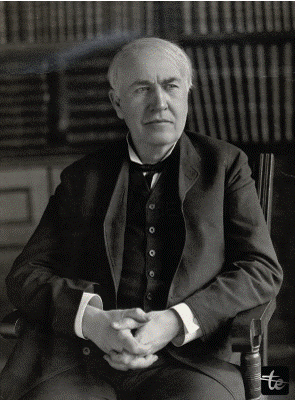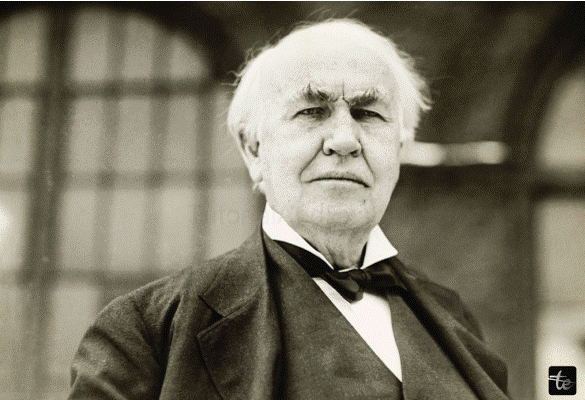Thomas Alva Edison
Introduction
Thomas Alva Edison was an extraordinary figure in the field of invention, renowned as one of the most innovative inventors in history. He devoted a large part of his life to creating designs that greatly influenced modern life. His significant inventions include the phonograph, motion picture camera, light bulb, mechanical vote recorder, stock ticker, battery for electric cars, and improvements to the telephone and telegraph systems. Edison was not just a brilliant inventor and businessman; He changed lives by making significant advances in various fields.
Thomas Alva Edison, a remarkable American inventor, holds the record for over 1000 patents, most notably 1093 patents (individually or collaboratively). He is also credited with establishing the first industrial research laboratory in history.
During his early years, he worked delivering newspapers to individuals on the Grand Trunk Railroad. This experience served as the inspiration for him to establish his newspaper, the "Grand Trunk Herald." The newspaper's prompt delivery of updated information resonated well with the public, leading to a rapid increase in its popularity. Notably, this venture marked Edison's initial entry into a series of future business endeavors.

Early Years
Thomas Edison was born in Milan, Ohio, in 1847, but his family moved to Port Huron, Michigan, in 1854. He was the youngest of seven children, and his parents were Nancy Mathews Elliott (1810–1871) and Samuel Ogden Edison Jr. (1804–1896). They originally hailed from Marshalltown, Nova Scotia. The Edison family lineage extended through New Jersey to the Netherlands, with the original surname being "Edison." Thomas's father, Samuel Edison, had participated in the Rebellion of 1837, leading him to immigrate to Vienna, Ontario, and later move from the area. Thomas's great-grandfather, John Edson, had earlier moved to Nova Scotia from New Jersey in 1784.
Edison's mother, a former teacher, played an important role in his early education, teaching him reading, writing, and fundamental mathematics concepts. Despite spending only a short time in formal schooling, Edison's innate curiosity led him to explore myriad subjects through self-directed reading. Known as an intelligent and curious boy, he reflected deeply on many subjects. A growing interest in technology marked his childhood, and he devoted many hours to experimenting at home.
At the age of 12, Thomas Edison began experiencing hearing problems, which were later attributed to a childhood illness with scarlet fever and persistent, untreated middle ear infections. Despite medical explanations, Edison fabricated elaborate stories about the origin of his deafness. Legend has it that he would bite a musical instrument or piano while attempting to absorb sound waves into his brain, as he was completely deaf in one ear. As he grew older, Edison came to believe that his hearing loss, rather than being a hindrance, actually enhanced his ability to concentrate more carefully and avoid distractions.
Initial Career
When Thomas Edison was young, he sold things on trains and earned about $50 a week by the age of 13. He used most of his money for experiments in electricity and chemistry. One day, Thomas Edison saved a child from a train accident, and the child's father, who worked with telegraphs, taught Edison how to use them. Edison got a job at a railway station in Ontario, Canada, and even though he faced challenges at work, he continued to conduct his experiments and study chemistry on the train. These early experiences helped shape Edison's remarkable career.
Edison, with the help of four staff members, founded the Grand Trunk Herald, which he distributed along with his other papers. He had special permission to sell newspapers on the route, demonstrating his early business skills. This venture marked the beginning of Edison's extensive journey as an entrepreneur. Ultimately, his entrepreneurial spirit laid the foundation for the creation of General Electric, now one of the largest traded companies in the world.
Thomas Edison As a Scientist
His most important creation, an industrial research laboratory, was established by Edison in 1876. Edison reportedly used a music player or piano to press his teeth into in order to experience sound waves in his brain because he had complete deafness in one ear and very limited hearing in the other. After seeing the telegraph in action, Edison wanted to know whether his initial price estimate of $4,000 to $5,000 was correct, so he requested a proposal from Western Union. He was shocked when he received a bid of $10,000.
Edison's first notable financial success was the quadrilateral telegraph, and Menlo Park marked the establishment of a company dedicated to ongoing technological progress. Although many employees contributed to research and development under Edison's leadership, he received legal credit for most innovations. His team generally followed his instructions during research, and Edison exerted significant pressure on them to deliver results.
Edison had two types of patents. One type called a utility patent, covered ideas for machines or chemicals and lasted for 17 years. Most of his inventions came from this group. They also had design patents, about twelve of them, which protected how things looked and lasted for 14 years. Most of Edison's inventions, like many of his patents, were improved versions of existing ideas. However, the phonograph patent stood out because it was the first patent to describe a machine that could record and play sounds.

Electric Light
In 1878, Edison began work on an electric lighting system to rival gas and oil lighting. His first task was to create a long-lasting incandescent lamp suitable for indoor lighting. However, Thomas Edison was unable to invent the light bulb.
British scientist Warren de La Rue created a powerful light bulb using tightly wrapped platinum filament in 1840. Unfortunately, the high cost of platinum prevented the light bulb from becoming a commercial success. Other inventors, including Henry Woodward, Matthew Evans, and Alessandro Volta, also worked on incandescent lamps, with Volta demonstrating a light string in 1800.
In 1878, J.P. With the support of additional investors such as Morgan and the Vanderbilts, P. Morgan, and members of Spencer Trask's family, Thomas Edison started the Edison Electric Light Company in New York City. Edison then demonstrated his incandescent light bulb for the first time in public in Menlo Park on December 31, 1879.
Carbon Telephone Transmitter
In 1876, Thomas Edison enhanced the telephone microphone by inventing the carbon microphone. It is made up of two metal plates separated by carbon granules. Acting as a "transmitter," the resistance changed depending on the strength of the applied sound waves. The corpuscles allowed a steady direct current, and their variable resistance controlled the current. This fluctuating electric current mimicked the pressure changes in the sound wave.
Before the invention of the carbon microphone, devices created by Johann Philipp Riis and Alexander Graham Bell operated by generating a weak current. The carbon microphone offered a different approach, using direct current that was modified. After this modulation, a transformer was employed to transmit the signal over the telephone line.
Many other inventors, including Edison, sought to develop a practical microphone for telecommunications by controlling the flow of electric current. David Edward Hughes and Emile Berliner both researched and published papers on the physics of loose-contact carbon transmitters. However, they ultimately lost the patent suit to Thomas Edison, who had simultaneously worked on a similar invention. It is worth noting that Hughes did not apply for a patent for his work.
Rechargeable Battery
In the late 1890s, Thomas Edison created a special type of rechargeable battery called an "accumulator." He wanted it to be more efficient and lighter. People can use these batteries to power their phonographs (music-playing instruments). But Edison had even bigger ideas – he thought these batteries could also be used for things like electric vehicles. Edison decided to use alkaline instead of acid because the rechargeable batteries available at the time, which used lead acid, were not very good. Plus, other companies already control that market.
Before settling on the nickel-iron combination, Edison conducted extensive laboratory experiments with over 10,000 material combinations. After receiving American and European patents for his nickel-iron battery, he founded the Edison Storage Battery Company in 1901, which employed about 450 employees by 1904. Early rechargeable batteries used for electric cars initially faced problems, leading to customer complaints and financial challenges for the company. When the company ran out of money, Edison personally financed the company. It was not until 1910 that Edison unveiled a fully developed device: a highly effective and long-lasting nickel-iron battery using lye as the electrolyte.
Family
At the age of 24, Edison married a young girl named Mary Stilwell when she was 16 years old. They met only two months before the wedding. Edison and Mary became the parents of three children: Marion Estelle Edison, William Leslie Edison, and Thomas Alva Edison Jr. Unfortunately, Mary died on August 9, 1884, at the young age of 29. Sources say that the cause of his death could be a brain tumor or morphine overdose.
After Mary Stilwell's death, Edison married Mina Miller on February 24, 1886, when he was 39 years old. Together with Mina, Edison had three more children: Charles Edison, Madeleine Edison, and Theodore Miller Edison.
Death
On October 18, 1931, Edison died at home. Several reports state that he died as a result of diabetic problems. He was buried behind his. After his death, Edison's mansion, "Glenmont," was located in Llewellyn Park in West Orange, New Jersey. Edison's final breath was stored in a test tube and then moved to the Henry Ford Museum near Detroit as a mark of respect and honor. It also retains other Edison-related relics as keepsakes.